Search Result
Results for "
(S)-( )-Arginine
" in MedChemExpress (MCE) Product Catalog:
1
Biochemical Assay Reagents
11
Isotope-Labeled Compounds
| Cat. No. |
Product Name |
Target |
Research Areas |
Chemical Structure |
-
- HY-N0455
-
|
(S)-(+)-Arginine
|
NO Synthase
Endogenous Metabolite
|
Cardiovascular Disease
Cancer
|
|
L-Arginine ((S)-(+)-Arginine) is the substrate for the endothelial nitric oxide synthase (eNOS) to generate NO. L-Arginine is transported into vascular smooth muscle cells by the cationic amino acid transporter family of proteins where it is metabolized to nitric oxide (NO), polyamines, or L-proline. L-Arginine is a potent vasodilator, and can be used to induce experimental acute pancreatitis .
|
-
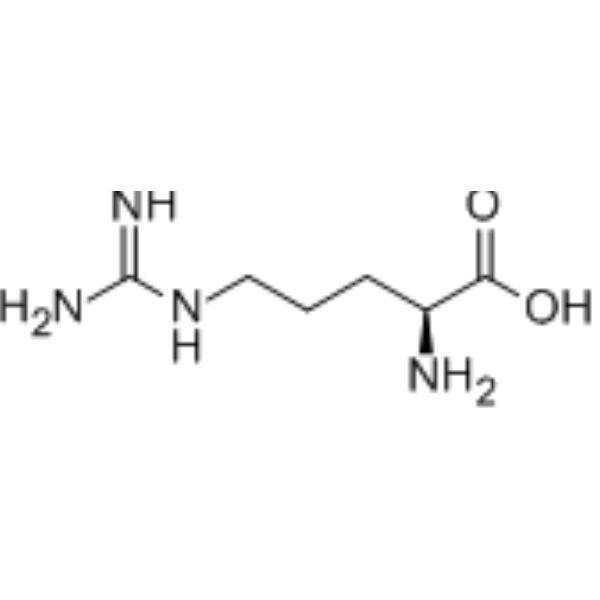
-
- HY-N0455A
-
|
(S)-(+)-Arginine hydrochloride
|
NO Synthase
Endogenous Metabolite
|
Cancer
|
|
L-Arginine ((S)-(+)-Arginine) is the substrate for the endothelial nitric oxide synthase (eNOS) to generate NO. L-Arginine is transported into vascular smooth muscle cells by the cationic amino acid transporter family of proteins where it is metabolized to nitric oxide (NO), polyamines, or L-proline. L-Arginine is a potent vasodilator, and can be used to induce experimental acute pancreatitis .
|
-
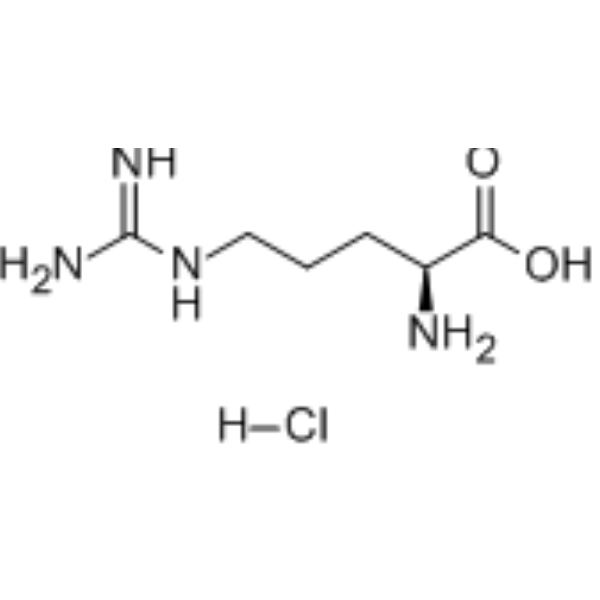
-
- HY-N0455D
-
|
(S)-(+)-Arginine butanoate
|
Others
|
Others
|
|
L-Arginine butanoate ((S)-(+)-Arginine butanoate) is a compound consisting of L-Arginine and butanoate. L-Arginine is one of the essential nutrients in the human body and participates in various biochemical processes. Butanoate is a short-chain fatty acid commonly used as a food additive and solvent in pharmaceutical formulations .
|
-
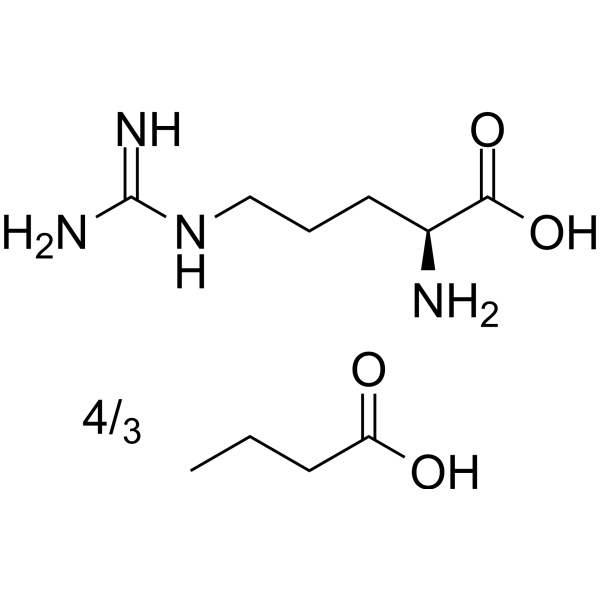
-
- HY-N0455B
-
|
(S)-(+)-Arginine (L-glutamate)
|
|
|
|
L-Arginine L-glutamate ((S)-(+)-Arginine L-glutamate) is the nitrogen donor for synthesis of nitric oxide. L-Arginine L-glutamate can be used for upper gastrointestinal hypofunction or dysfunction like functional dyspepsia research .
|
-
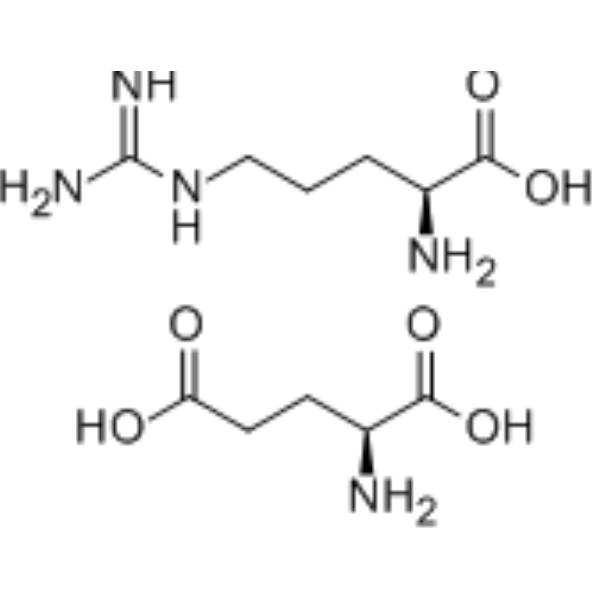
-
- HY-N0455AS2
-
|
(S)-(+)-Arginine-d7 hydrochloride
|
NO Synthase
Endogenous Metabolite
|
Others
|
|
L-Arginine-d7 (hydrochloride) is the deuterium labeled L-Arginine hydrochloride. L-Arginine hydrochloride ((S)-(+)-Arginine hydrochloride) is the nitrogen donor for synthesis of nitric oxide, a potent vasodilator that is deficient during times of sickle cell crisis.
|
-

-
- HY-N0455AS7
-
|
(S)-(+)-Arginine-13C hydrochloride
|
NO Synthase
Endogenous Metabolite
|
Others
|
|
L-Arginine- 13C (hydrochloride) is the 13C-labeled L-Arginine hydrochloride. L-Arginine hydrochloride ((S)-(+)-Arginine hydrochloride) is the nitrogen donor for synthesis of nitric oxide, a potent vasodilator that is deficient during times of sickle cell crisis.
|
-

-
- HY-N0455AS3
-
|
(S)-(+)-Arginine-1-13C hydrochloride
|
NO Synthase
Endogenous Metabolite
|
Others
|
|
L-Arginine-1- 13C (hydrochloride) is the 13C-labeled L-Arginine hydrochloride. L-Arginine hydrochloride ((S)-(+)-Arginine hydrochloride) is the nitrogen donor for synthesis of nitric oxide, a potent vasodilator that is deficient during times of sickle cell crisis.
|
-

-
- HY-N0455AS
-
|
(S)-(+)-Arginine-15N2 hydrochloride
|
NO Synthase
Endogenous Metabolite
|
Others
|
|
L-Arginine- 15N2 (hydrochloride) is the 15N-labeled L-Arginine (hydrochloride). L-Arginine hydrochloride ((S)-(+)-Arginine hydrochloride) is the nitrogen donor for synthesis of nitric oxide, a potent vasodilator that is deficient during times of sickle cell crisis.
|
-

-
- HY-N0455AS6
-
|
(S)-(+)-Arginine-13C6 hydrochloride
|
Isotope-Labeled Compounds
NO Synthase
Endogenous Metabolite
|
Others
|
|
L-Arginine- 13C6 (hydrochloride) is the 13C-labeled L-Arginine hydrochloride. L-Arginine hydrochloride ((S)-(+)-Arginine hydrochloride) is the nitrogen donor for synthesis of nitric oxide, a potent vasodilator that is deficient during times of sickle cell crisis.
|
-

-
- HY-N0455AS11
-
|
(S)-(+)-Arginine-13C6,d14 hydrochloride
|
Isotope-Labeled Compounds
Endogenous Metabolite
|
Cancer
|
|
L-Arginine-13C6,d14 hydrochloride ((S)-(+)-Arginine-13C6,d14 hydrochloride) is a deuterated derivative of L-Arginine hydrochloride (HY-N0455A) that is labeled with 13C6. L-Arginine hydrochloride ((S)-(+)-Arginine hydrochloride) serves as a nitrogen donor for the synthesis of nitric oxide and is a vasodilator .
|
-
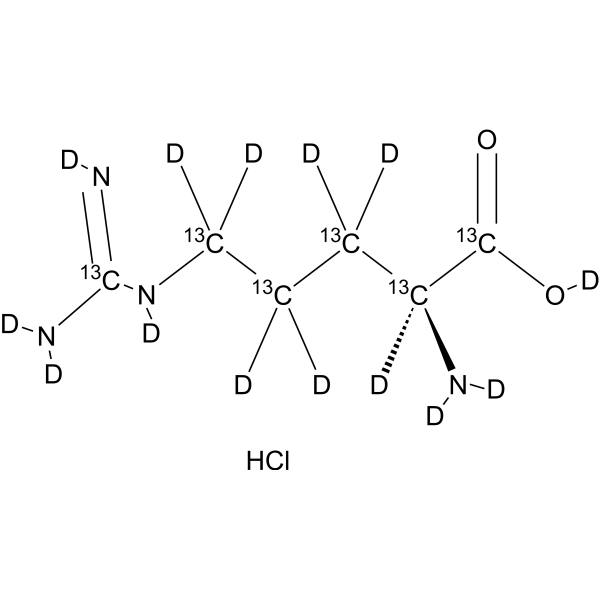
-
- HY-N0455AS1
-
|
(S)-(+)-Arginine-15N4 hydrochloride
|
Isotope-Labeled Compounds
NO Synthase
Endogenous Metabolite
|
Others
|
|
L-Arginine- 15N4 (hydrochloride) is the 15N-labeled L-Arginine hydrochloride. L-Arginine hydrochloride ((S)-(+)-Arginine hydrochloride) is the nitrogen donor for synthesis of nitric oxide, a potent vasodilator that is deficient during times of sickle cell crisis[1].
|
-

-
- HY-N0455AS5
-
|
(S)-(+)-Arginine-1,2-13C2 hydrochloride
|
Isotope-Labeled Compounds
NO Synthase
Endogenous Metabolite
|
Others
|
|
L-Arginine-1,2- 13C2 (hydrochloride) is the 13C-labeled L-Arginine hydrochloride. L-Arginine hydrochloride ((S)-(+)-Arginine hydrochloride) is the nitrogen donor for synthesis of nitric oxide, a potent vasodilator that is deficient during times of sickle cell crisis.
|
-

-
- HY-N0455AS9
-
|
(S)-(+)-Arginine-15N4,d7 hydrochloride
|
Isotope-Labeled Compounds
NO Synthase
Endogenous Metabolite
|
Others
|
|
L-Arginine- 15N4,d7 (hydrochloride) is the deuterium and 15N-labeled L-Arginine hydrochloride. L-Arginine hydrochloride ((S)-(+)-Arginine hydrochloride) is the nitrogen donor for synthesis of nitric oxide, a potent vasodilator that is deficient during times of sickle cell crisis.
|
-

-
- HY-N0455AS8
-
|
(S)-(+)-Arginine-13C6,15N4 hydrochloride
|
NO Synthase
Endogenous Metabolite
|
Others
|
|
L-Arginine- 13C6, 15N4 (hydrochloride) is the 13C- and 15N-labeled L-Arginine hydrochloride. L-Arginine hydrochloride ((S)-(+)-Arginine hydrochloride) is the nitrogen donor for synthesis of nitric oxide, a potent vasodilator that is deficient during times of sickle cell crisis.
|
-

-
- HY-N0455AS4
-
|
(S)-(+)-Arginine-13C6,15N4,d7 hydrochloride
|
Isotope-Labeled Compounds
NO Synthase
Endogenous Metabolite
|
Others
|
|
L-Arginine- 13C6, 15N4,d7 (hydrochloride) is the deuterium, 13C-, and 15-labeled L-Arginine hydrochloride. L-Arginine hydrochloride ((S)-(+)-Arginine hydrochloride) is the nitrogen donor for synthesis of nitric oxide, a potent vasodilator that is deficient during times of sickle cell crisis.
|
-

-
- HY-W013305
-
-

-
- HY-W010913
-
-
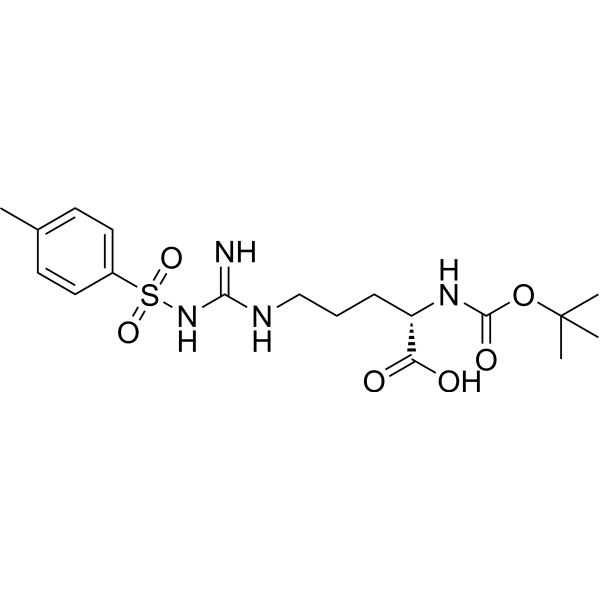
-
- HY-W128037
-
-

-
- HY-128717
-
|
EPZ019997
|
Histone Methyltransferase
|
Cancer
|
|
GSK3368715 (EPZ019997) is an orally active, reversible, and S-adenosyl-L-methionine (SAM) uncompetitive type I protein arginine methyltransferases (PRMTs) inhibitor (IC50=3.1 nM (PRMT1), 48 nM (PRMT3), 1148 nM (PRMT4), 5.7 nM (PRMT6), 1.7 nM (PRMT8)). GSK3368715 (EPZ019997) produces a shift in arginine methylation states, alters exon usage, and has strong anti-cancer activity .
|
-
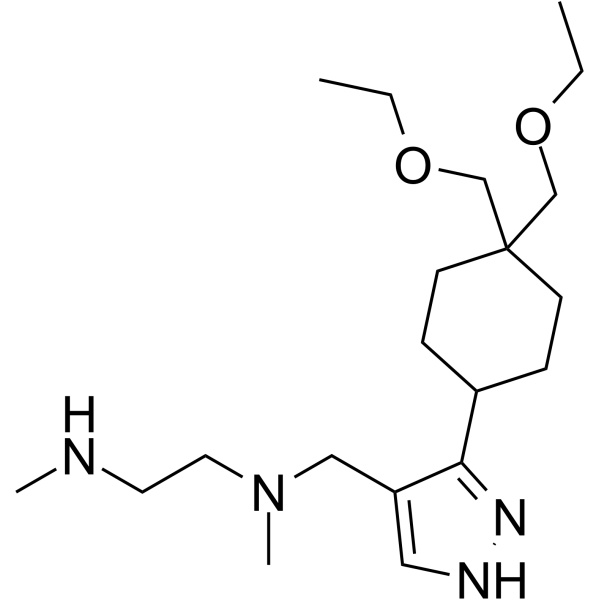
-
- HY-128717A
-
|
EPZ019997 dihydrochloride
|
Histone Methyltransferase
|
Cancer
|
|
GSK3368715 dihydrochloride (EPZ019997 dihydrochloride) is an orally active, reversible, and S-adenosyl-L-methionine (SAM) uncompetitive type I protein arginine methyltransferases (PRMTs) inhibitor (IC50=3.1 nM (PRMT1), 48 nM (PRMT3), 1148 nM (PRMT4), 5.7 nM (PRMT6), 1.7 nM (PRMT8)). GSK3368715 dihydrochloride (EPZ019997 dihydrochloride) produces a shift in arginine methylation states, alters exon usage, and has strong anti-cancer activity .
|
-
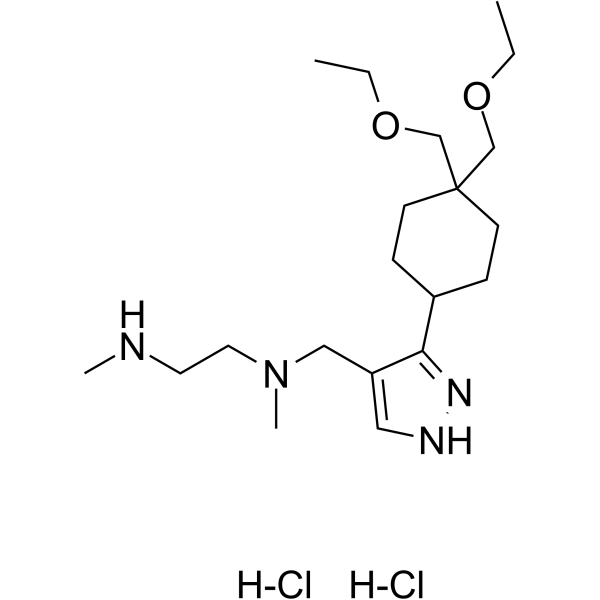
-
- HY-128717B
-
|
EPZ019997 trihydrochloride
|
Histone Methyltransferase
|
Cancer
|
|
GSK3368715 trihydrochloride (EPZ019997) is an orally active, reversible, and S-adenosyl-L-methionine (SAM) uncompetitive type I protein arginine methyltransferases (PRMTs) inhibitor (IC50=3.1 nM (PRMT1), 48 nM (PRMT3), 1148 nM (PRMT4), 5.7 nM (PRMT6), 1.7 nM (PRMT8)). GSK3368715 trihydrochloride (EPZ019997) produces a shift in arginine methylation states, alters exon usage, and has strong anti-cancer activity .
|
-
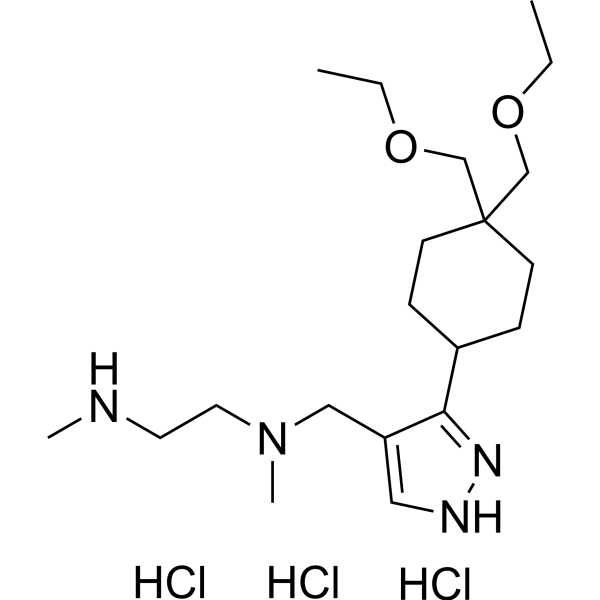
-
- HY-155154
-
|
|
Others
|
Cancer
|
|
PRMT4-IN-2 (compound 55) is a pan-inhibitor of protein arginine methyltransferase (PRMT) with IC50s of 92 nM (PRMT4), 436 nM (PRMT6), 460 nM (PRMT1), 823 nM ( PRMT8), 1.386 μM (PRMT3) .
|
-
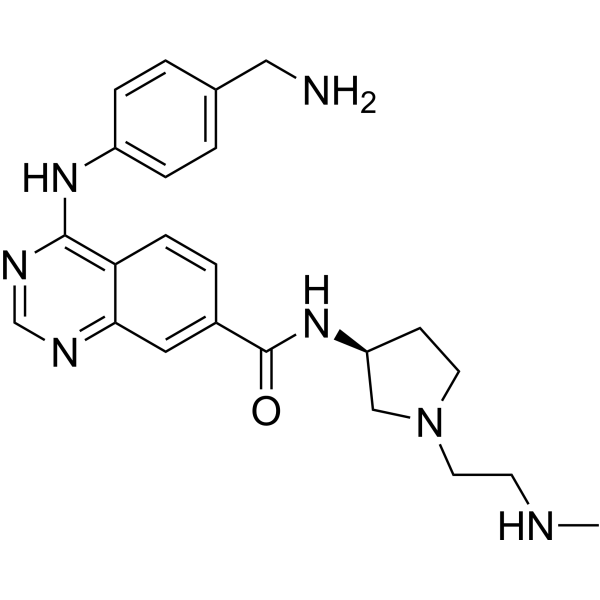
-
- HY-19615
-
|
|
Histone Methyltransferase
|
Cancer
|
|
MS023 is a potent, selective, and cell-active inhibitor of human type I protein arginine methyltransferases (PRMTs) inhibitor, with IC50s of 30, 119, 83, 4 and 5 nM for PRMT1, PRMT3, PRMT4, PRMT6, and PRMT8, respectively .
|
-

-
- HY-19615B
-
|
|
Histone Methyltransferase
|
Cancer
|
|
MS023 dihydrochloride is a potent, selective, and cell-active inhibitor of human type I protein arginine methyltransferases (PRMTs) inhibitor, with IC50s of 30, 119, 83, 4 and 5 nM for PRMT1, PRMT3, PRMT4, PRMT6, and PRMT8, respectively .
|
-
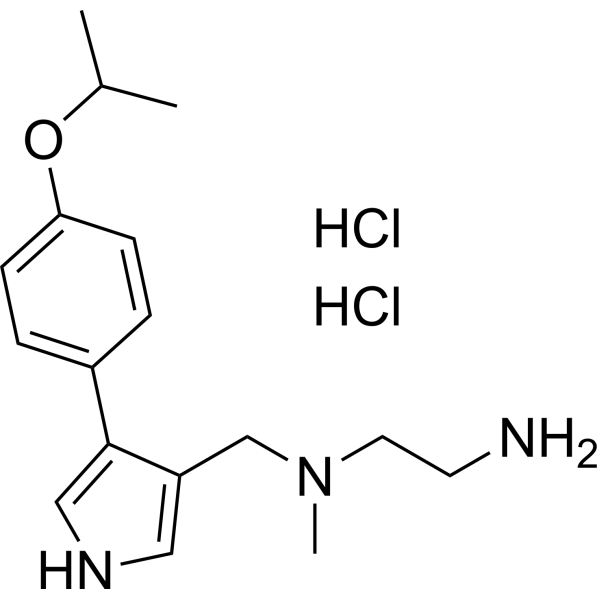
-
- HY-19615A
-
|
|
Histone Methyltransferase
|
Cancer
|
|
MS023 trihydrochloride is a potent, selective, and cell-active inhibitor of human type I protein arginine methyltransferases (PRMTs) inhibitor, with IC50s of 30, 119, 83, 4 and 5 nM for PRMT1, PRMT3, PRMT4, PRMT6, and PRMT8, respectively .
|
-
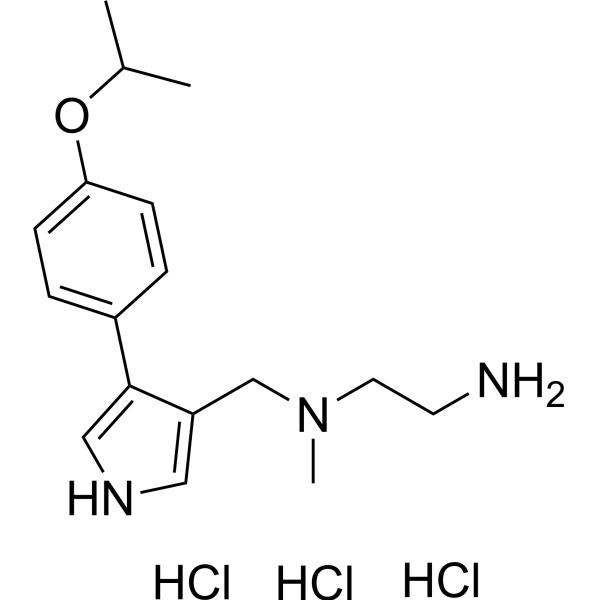
-
- HY-128579
-
|
|
Histone Methyltransferase
|
Cancer
|
|
DW14800 is a protein arginine methyltransferase 5 (PRMT5) inhibitor, with an IC50 of 17 nM. DW14800 reduces H4R3me2s levels and enhances the transcription of HNF4α, but does not alter PRMT5 expression. Anti-cancer activity .
|
-

-
- HY-18962
-
|
|
Histone Methyltransferase
|
Cancer
|
|
AMI-1 is a potent, cell-permeable and reversible inhibitor of protein arginine N-methyltransferases (PRMTs), with IC50s of 8.8 μM and 3.0 μM for human PRMT1 and yeast-Hmt1p, respectively. AMI-1 exerts PRMTs inhibitory effects by blocking peptide-substrate binding .
|
-
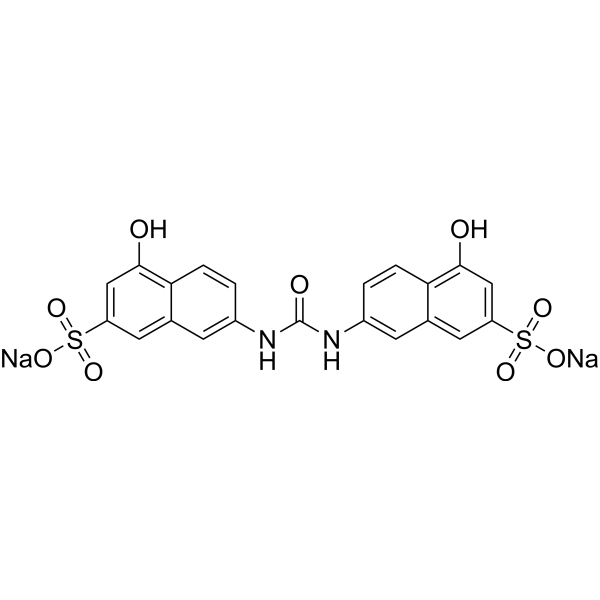
-
- HY-18962A
-
|
|
Histone Methyltransferase
|
Cancer
|
|
AMI-1 free acid is a potent, cell-permeable and reversible inhibitor of protein arginine N-methyltransferases (PRMTs), with IC50s of 8.8 μM and 3.0 μM for human PRMT1 and yeast-Hmt1p, respectively. AMI-1 free acid exerts PRMTs inhibitory effects by blocking peptide-substrate binding .
|
-
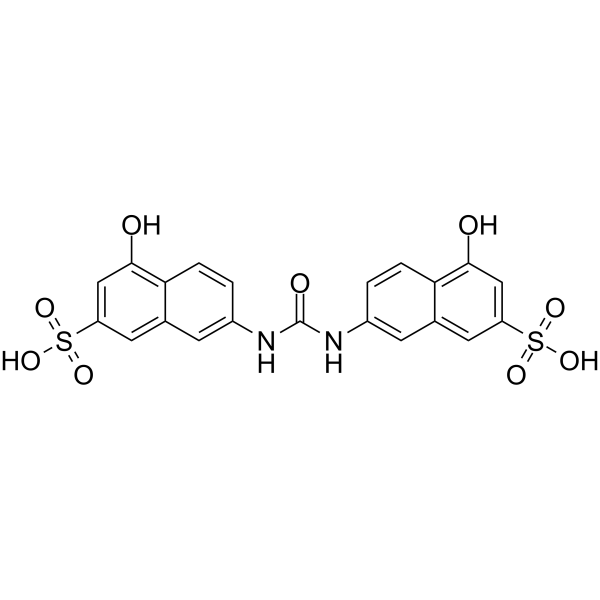
-
- HY-129047
-
Trypsin
4 Publications Verification
|
Ser/Thr Protease
Protease Activated Receptor (PAR)
|
Infection
Inflammation/Immunology
|
|
Trypsin is a serine protease enzyme, and hydrolyzes proteins at the carboxyl side of the Lysine or Arginine. Trypsin activates PAR2 and PAR4. Trypsin induces cell-to-cell membrane fusion in PDCoV infection by the interaction of S glycoprotein of PDCoV and pAPN. Trypsin also promotes cell proliferation and differentiation. Trypsin can be used in the research of wound healing and neurogenic inflammation .
|
-

-
- HY-129047A
-
|
|
Ser/Thr Protease
Protease Activated Receptor (PAR)
|
Infection
Inflammation/Immunology
|
|
Trypsin MS grade is a serine protease enzyme, and hydrolyzes proteins at the carboxyl side of the Lysine or Arginine. Trypsin MS grade activates PAR2 and PAR4. Trypsin MS grade induces cell-to-cell membrane fusion in PDCoV infection by the interaction of S glycoprotein of PDCoV and pAPN. Trypsin MS grade also promotes cell proliferation and differentiation. Trypsin MS grade can be used in the research of wound healing and neurogenic inflammation .
|
-

-
- HY-110137A
-
|
DB75; NSC 305831
|
Histone Methyltransferase
Phosphodiesterase (PDE)
Parasite
|
Infection
Inflammation/Immunology
Cancer
|
|
Furamidine (DB75) is a selective protein arginine methyltransferase 1 (PRMT1) inhibitor with an IC50 of 9.4 μM. Furamidine is selective for PRMT1 over PRMT5, PRMT6, and PRMT4 (CARM1) (IC50s of 166 µM, 283 µM, and >400 µM, respectively). Furamidine is a potent, reversible and competitive tyrosyl-DNA phosphodiesterase 1 (TDP-1) inhibitor. Inhibition of TDP-1 by Furamidine is effective both with single- and double-stranded DNA substrates but is slightly stronger with the duplex DNA. Furamidine is also an antiparasite agent .
|
-
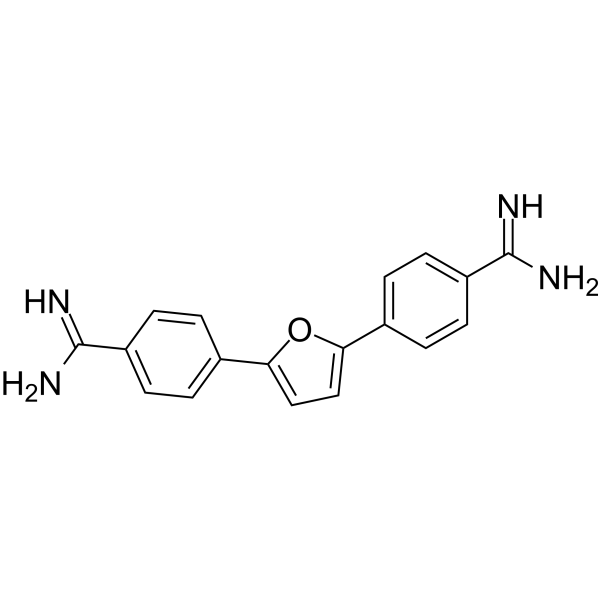
-
- HY-110137
-
|
DB75 dihydrochloride; NSC 305831 dihydrochloride
|
Histone Methyltransferase
Phosphodiesterase (PDE)
Parasite
|
Infection
Inflammation/Immunology
Cancer
|
|
Furamidine dihydrochloride (DB75 dihydrochloride) is a selective protein arginine methyltransferase 1 (PRMT1) inhibitor with an IC50 of 9.4 μM. Furamidine dihydrochloride is selective for PRMT1 over PRMT5, PRMT6, and PRMT4 (CARM1) (IC50s of 166 µM, 283 µM, and >400 µM, respectively). Furamidine dihydrochloride is a potent, reversible and competitive tyrosyl-DNA phosphodiesterase 1 (TDP-1) inhibitor. Inhibition of TDP-1 by Furamidine dihydrochloride is effective both with single- and double-stranded DNA substrates but is slightly stronger with the duplex DNA. Furamidine dihydrochloride is also an antiparasite agent .
|
-
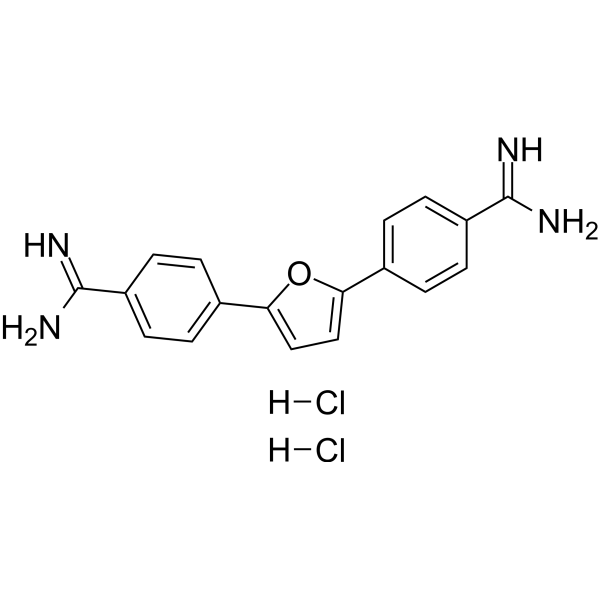
| Cat. No. |
Product Name |
Type |
-
- HY-129047
-
Trypsin
4 Publications Verification
|
Biochemical Assay Reagents
|
|
Trypsin is a serine protease enzyme, and hydrolyzes proteins at the carboxyl side of the Lysine or Arginine. Trypsin activates PAR2 and PAR4. Trypsin induces cell-to-cell membrane fusion in PDCoV infection by the interaction of S glycoprotein of PDCoV and pAPN. Trypsin also promotes cell proliferation and differentiation. Trypsin can be used in the research of wound healing and neurogenic inflammation .
|
| Cat. No. |
Product Name |
Target |
Research Area |
| Cat. No. |
Product Name |
Category |
Target |
Chemical Structure |
| Cat. No. |
Product Name |
Chemical Structure |
-
- HY-N0455AS2
-
|
|
|
L-Arginine-d7 (hydrochloride) is the deuterium labeled L-Arginine hydrochloride. L-Arginine hydrochloride ((S)-(+)-Arginine hydrochloride) is the nitrogen donor for synthesis of nitric oxide, a potent vasodilator that is deficient during times of sickle cell crisis.
|
-

-
- HY-N0455AS
-
|
|
|
L-Arginine- 15N2 (hydrochloride) is the 15N-labeled L-Arginine (hydrochloride). L-Arginine hydrochloride ((S)-(+)-Arginine hydrochloride) is the nitrogen donor for synthesis of nitric oxide, a potent vasodilator that is deficient during times of sickle cell crisis.
|
-

-
- HY-N0455AS6
-
|
|
|
L-Arginine- 13C6 (hydrochloride) is the 13C-labeled L-Arginine hydrochloride. L-Arginine hydrochloride ((S)-(+)-Arginine hydrochloride) is the nitrogen donor for synthesis of nitric oxide, a potent vasodilator that is deficient during times of sickle cell crisis.
|
-

-
- HY-N0455AS7
-
|
|
|
L-Arginine- 13C (hydrochloride) is the 13C-labeled L-Arginine hydrochloride. L-Arginine hydrochloride ((S)-(+)-Arginine hydrochloride) is the nitrogen donor for synthesis of nitric oxide, a potent vasodilator that is deficient during times of sickle cell crisis.
|
-

-
- HY-N0455AS3
-
|
|
|
L-Arginine-1- 13C (hydrochloride) is the 13C-labeled L-Arginine hydrochloride. L-Arginine hydrochloride ((S)-(+)-Arginine hydrochloride) is the nitrogen donor for synthesis of nitric oxide, a potent vasodilator that is deficient during times of sickle cell crisis.
|
-

-
- HY-N0455AS11
-
|
|
|
L-Arginine-13C6,d14 hydrochloride ((S)-(+)-Arginine-13C6,d14 hydrochloride) is a deuterated derivative of L-Arginine hydrochloride (HY-N0455A) that is labeled with 13C6. L-Arginine hydrochloride ((S)-(+)-Arginine hydrochloride) serves as a nitrogen donor for the synthesis of nitric oxide and is a vasodilator .
|
-

-
- HY-N0455AS1
-
|
|
|
L-Arginine- 15N4 (hydrochloride) is the 15N-labeled L-Arginine hydrochloride. L-Arginine hydrochloride ((S)-(+)-Arginine hydrochloride) is the nitrogen donor for synthesis of nitric oxide, a potent vasodilator that is deficient during times of sickle cell crisis[1].
|
-

-
- HY-N0455AS5
-
|
|
|
L-Arginine-1,2- 13C2 (hydrochloride) is the 13C-labeled L-Arginine hydrochloride. L-Arginine hydrochloride ((S)-(+)-Arginine hydrochloride) is the nitrogen donor for synthesis of nitric oxide, a potent vasodilator that is deficient during times of sickle cell crisis.
|
-

-
- HY-N0455AS9
-
|
|
|
L-Arginine- 15N4,d7 (hydrochloride) is the deuterium and 15N-labeled L-Arginine hydrochloride. L-Arginine hydrochloride ((S)-(+)-Arginine hydrochloride) is the nitrogen donor for synthesis of nitric oxide, a potent vasodilator that is deficient during times of sickle cell crisis.
|
-

-
- HY-N0455AS8
-
|
|
|
L-Arginine- 13C6, 15N4 (hydrochloride) is the 13C- and 15N-labeled L-Arginine hydrochloride. L-Arginine hydrochloride ((S)-(+)-Arginine hydrochloride) is the nitrogen donor for synthesis of nitric oxide, a potent vasodilator that is deficient during times of sickle cell crisis.
|
-

-
- HY-N0455AS4
-
|
|
|
L-Arginine- 13C6, 15N4,d7 (hydrochloride) is the deuterium, 13C-, and 15-labeled L-Arginine hydrochloride. L-Arginine hydrochloride ((S)-(+)-Arginine hydrochloride) is the nitrogen donor for synthesis of nitric oxide, a potent vasodilator that is deficient during times of sickle cell crisis.
|
-

Your information is safe with us. * Required Fields.
Inquiry Information
- Product Name:
- Cat. No.:
- Quantity:
- MCE Japan Authorized Agent:








































